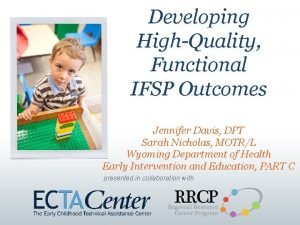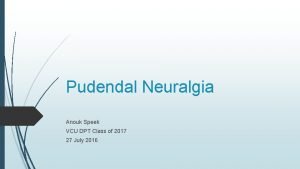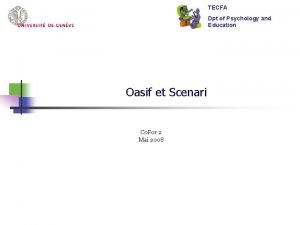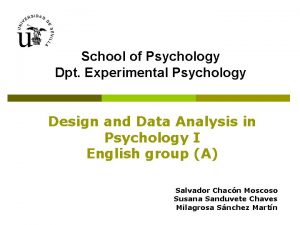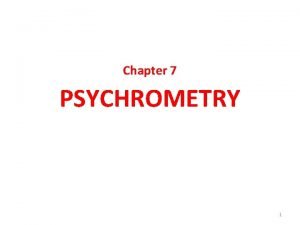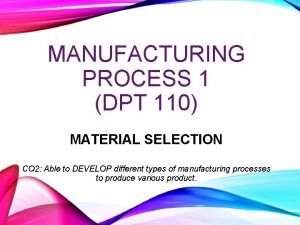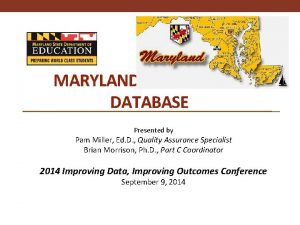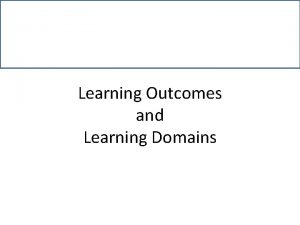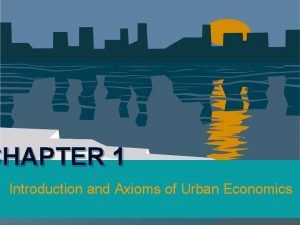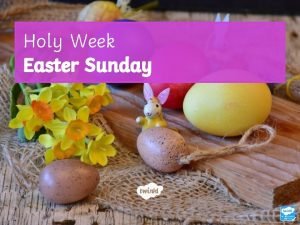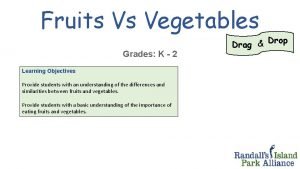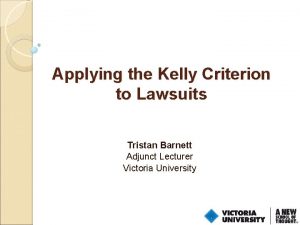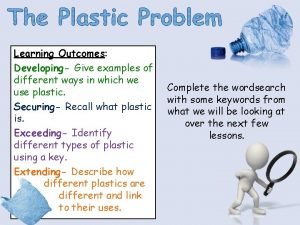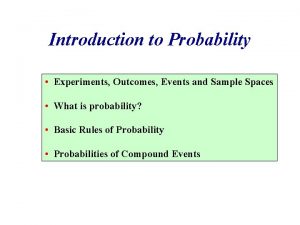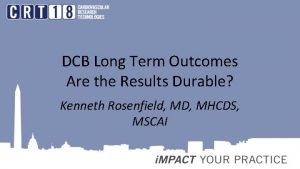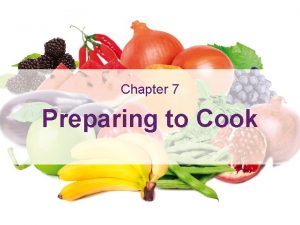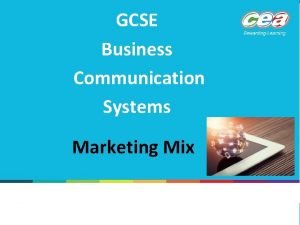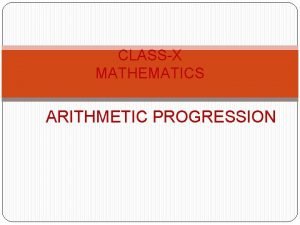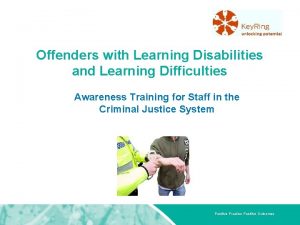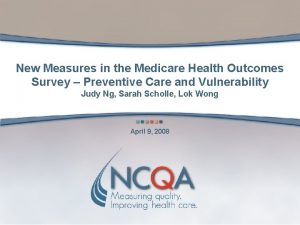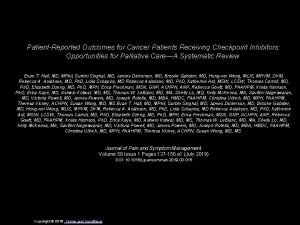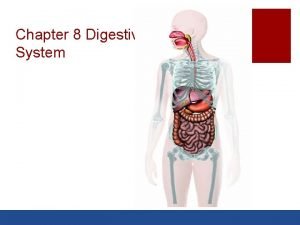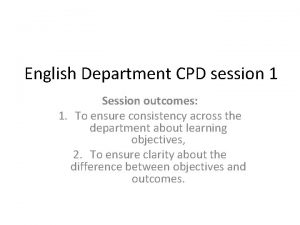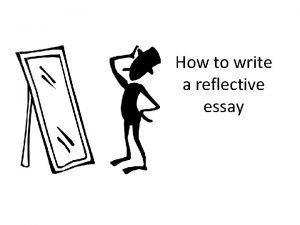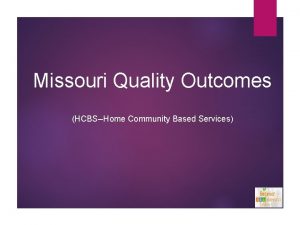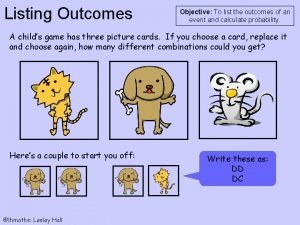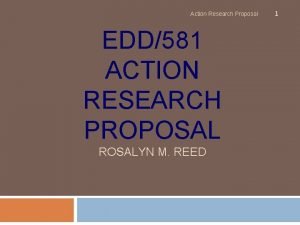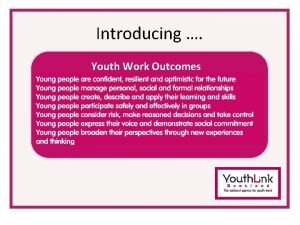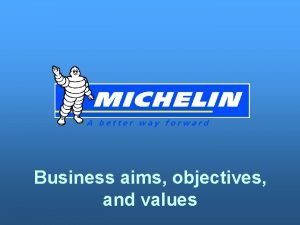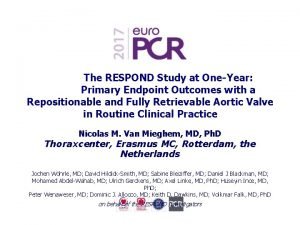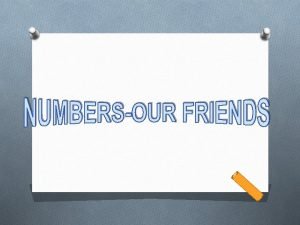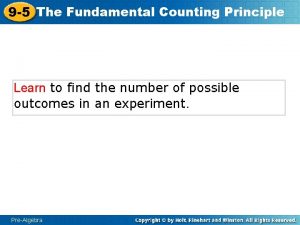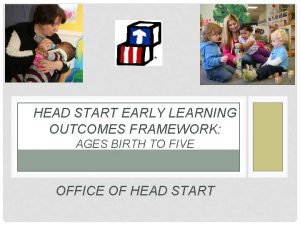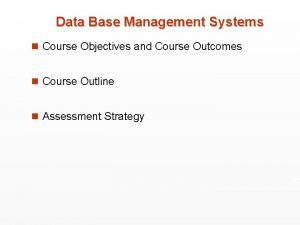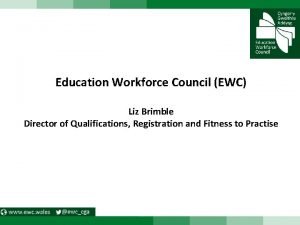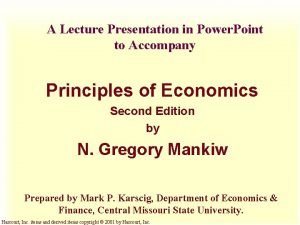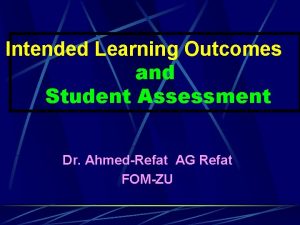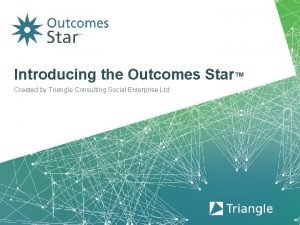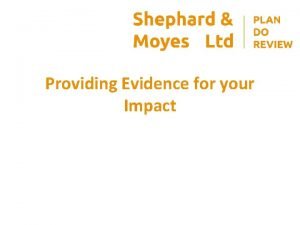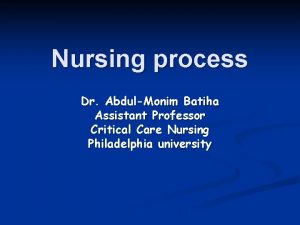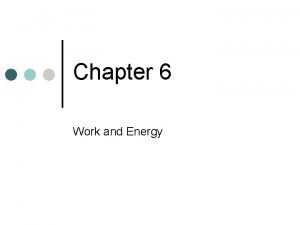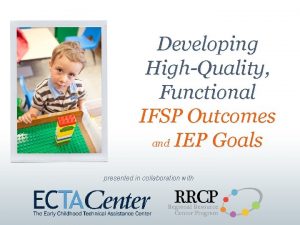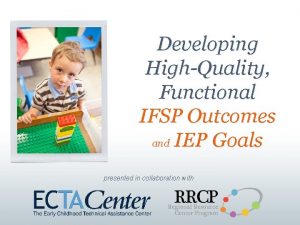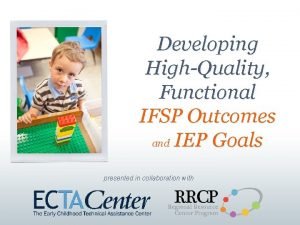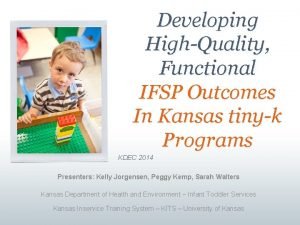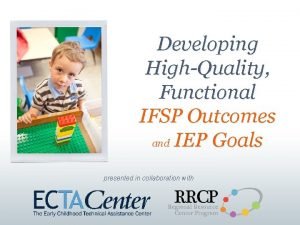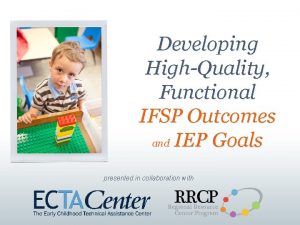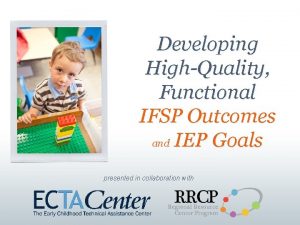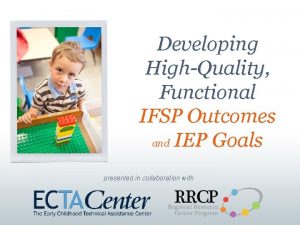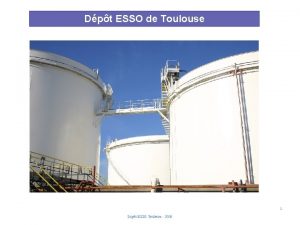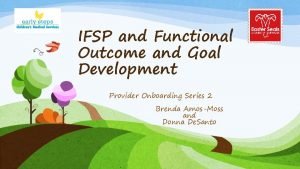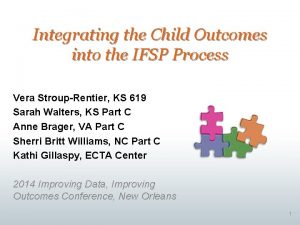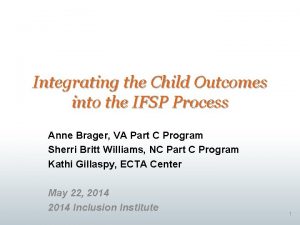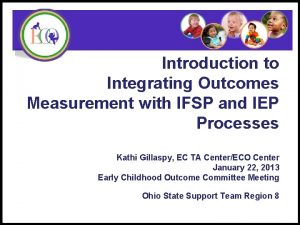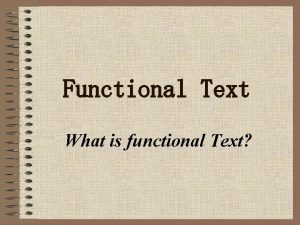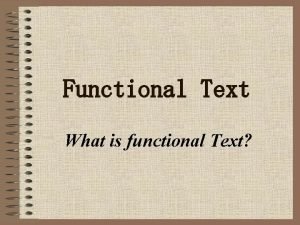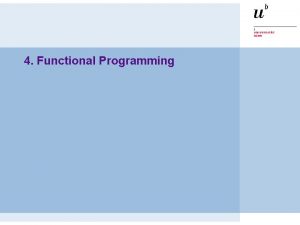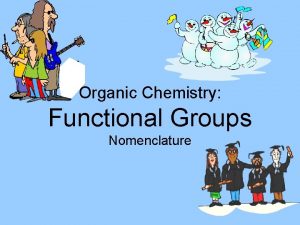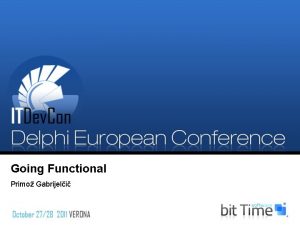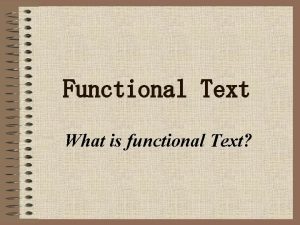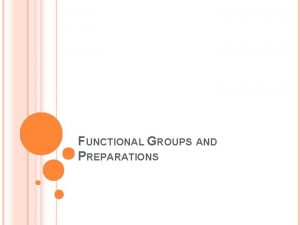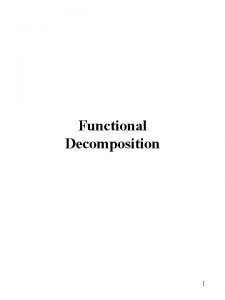Developing HighQuality Functional IFSP Outcomes Jennifer Davis DPT





























































- Slides: 61

Developing High-Quality, Functional IFSP Outcomes Jennifer Davis, DPT Sarah Nicholas, MOTR/L Wyoming Department of Health Early Intervention and Education, PART C presented in collaboration with

Developers Anne Lucas ECTA Center / WRRC Kathi Gillaspy ECTA Center Mary Peters ECTA Center With contributions from Naomi Younggren, Department of Defense/Army Early Intervention; Debbie Cate, ECTA Center; Megan Vinh, WRRC; Joicey Hurth, ECTA Center/NERRC; Christina Kasprzak, ECTA Center; and Grace Kelley, SERRC 2

Objectives In this session you will: • Discuss How Children Learn • Discuss Mission, Goals and Outcomes of Early Intervention • Link Assessment Information to IFSP Outcomes • Integrate the Global Child Outcomes Measurement into the IFSP • Learn IFSP Outcome Requirements • Develop Functional, High Quality IFSP Outcomes • Develop IFSP Strategies • Determine Services to Meet Outcomes 3

SECTION 1 ______________________________ SETTING THE CONTEXT • How Children Learn • Mission, Goals and Outcomes of Early Intervention

How Children Learn • Natural learning opportunities • Every day routines and activities of children and families • Within family and community life Dunst, C. J. , Bruder, M. B. , Trivette, C. M. , Raab, M. , & Mc. Lean, M. (2001). Natural learning opportunities for infants, toddlers, and preschoolers. Young Exceptional Children, 4(3), 18 -25. (Erratum in Young Exceptional Children, 4(4), 25) Shelden, M. L. , & Rush, D. D. (2001). The ten myths about providing early intervention services in natural environments. Infants & Young Children, 14(1), 1 -13. 5

Context for Learning: Child Interest and Competence Interests Exploration and Mastery Learning Activities Engagement Competence Dunst, C. J. , Herter, S. , & Shields, H. (2000). Interest-based natural learning opportunities. Young Exceptional Children Monograph Series No. 2: Natural Environments and Inclusion, 37 -48. 6

Interest-based Learning Children’s interests influence: • Participation in activities • Level of engagement in activities • Amount of practice of new skills • Development of new competencies • Sense of mastery Raab, M. (2005). Interest-based child participation in everyday learning activities. CASEin. Point, 1(2). Retrieved from http: //www. fippcase. org/index. php 7

Defining Engagement “…amount of time children spend interacting appropriately with their environment. ” Mc. William, R. A. (April, 2010). Enhancing Services in Natural Environments [webinar]. Retrieved from http: //www. ectacenter. org/~pdfs/calls/2004/partcsettings/mcwilliam. p df 8

Engagement of Children with Disabilities “Children with disabilities spend more time non-engaged (e. g. , wandering around, crying or waiting) than do their typically developing peers. ” Mc. William, R. A. (n. d. ) Engagement. Siskin Children’s Institute. Retrieved August 2012 from http: //www. siskin. org/www/docs/112. 181 9

Practice for Children with Disabilities • Research on young children with disabilities tells us they need even more practice: twice as much for 50% delay, etc. • They need opportunities to learn – in context (walking on rugs and yards and gravel); instruction, coaching and most of all. . . practice! Mahoney, G. (2008). The critical role of practice in the early childhood curriculum. Presentation at South Carolina Early Intervention Conference for Families and Providers. 10

Children Learn through Incredible Amounts of Practice! • The amount of a toddler’s experience with walking is the only predictor of improved proficiency • Toddlers practice walking for more than 6 hours daily • Average 500 – 1500 steps per hour • 9000 steps per day (length of 29 football fields!) Adolph, K. E. , Vereijken, B. , & Shrout, P. E. (2003). What Changes in Infant Walking and Why. Child Development, 74(2), 475 -97. 11

Mastery of functional skills occurs through high-frequency, naturally occurring activities in a variety of settings that are consistent with family and community life. Shelden, M. L. , & Rush, D. D. (2001). The ten myths about providing early intervention services in natural environments. Infants & Young Children, 14(1), 1 -13. Dunst, C. J. , & Bruder, M. B. (1999). Family and community activity settings, natural learning environments, and children’s learning opportunities. Children’s Learning Opportunities Report, 1(2). Dunst, C. J. , Bruder, M. B. , Trivette, C. M. , Hamby, D. , Raab, M. , & Mc. Lean, M. (2001). Characteristics and consequences of everyday natural learning opportunities. Topics in Early Childhood Special Education, 21(2), 68 -92. Dunst, C. J. , Bruder, M. B. , Trivette, C. M. , Raab, M. , & Mc. Lean, M. (2001). Natural learning opportunities forinfants, toddlers, and preschoolers. Young Exceptional Children, 4(3), 18 -25. (Erratum in Young Exceptional Children, 4(4), 25) Dunst, C. J. , Hamby, D. , Trivette, C. M. , Raab, M. , & Bruder, M. B. (2002). Young children's participation in everyday family and community activity. Psychological Reports, 91, 875 -897. 12

Keys to Development • Child’s opportunities to practice are increased when parents/caregivers/teachers: – select everyday activities that are interesting to the child or foster situational learning – are responsive to a child’s play • Without adequate practice to master a fundamental skill, a child cannot move to the next developmental level • It takes the time it takes! Mahoney, G. (2008). The critical role of practice in the early childhood curriculum. Presentation at South Carolina Early Intervention Conference for Families and Providers. Raab, M. (2005). Interest-based child participation in everyday learning activities. CASEin. Point, 1(2). Retrieved from http: //www. fippcase. org/index. php 13

Services Focus on Successful Participation • Services should strengthen family and caregivers capacity to use multiple routines and activities as learning opportunities • Successful participation = learning and practice = mastery of skills • Services should also help families and caregivers figure out how to address challenging activities by improving the child’s skills, making adaptations so s/he can be more successful 14

Parents and Caregivers Influence Learning • What happens between intervention visits is most critical for learning • The consistent adults in a child’s life have the greatest influence on the child’s learning and development – not providers/teachers • All families/caregivers have strengths and capabilities that can be used to help their child develop and learn 15

Supporting Parents and Caregivers • Shares knowledge and resources with a child’s key caregivers through adult-to-adult relationships • Family members are supported in their day-to-day responsibilities of caring for their child Hanft, B. (April, 2010). Enhancing Services in Natural Environments [webinar]. Retrieved from http: //www. ectacenter. org/~pdfs/calls/2004/partcsettings/hanft. pdf 16

Goals of Early Intervention and Early Childhood Special Education For children to enable young children to be active and successful participants during the early childhood years and in the future in a variety of settings – in their homes with their families, in child care, preschool or school programs, and in the community For families to enable families to provide care for their child and have the resources they need to participate in their own desired family and community activities The Early Childhood Outcomes Center (2005). Family and Child Outcomes for Early Intervention and Early Childhood Special Education. Retrieved from http: //www. ectacenter. org/eco/assets/pdfs/ECO_Outcomes_4 -13 -05. pdf 17

Mission of Early Intervention Services Part C early intervention builds upon and provides supports and resources to assist family members and caregivers to enhance children’s learning and development through everyday learning opportunities. • Mission and Key Principles of Early Intervention Services http: //www. ectacenter. org/~pdfs/topics/families/Finalmissionandprinciples 3_11_08. pdf • Seven Key Principles Looks Like/Doesn’t Look Like http: //www. ectacenter. org/~pdfs/topics/families/Principles_Looks. Like_Doesnt. Look. Like 3_11_08. pdf 18

Integrating Outcome Measurement into IFSP • The IFSP process plans supports and services to address priorities and to support successful participation in daily activities • Individual outcomes for each child build on his/her interests/skills and reduce barriers to successful participation in daily learning opportunities • Through participation – all children learn (interest -based learning, practice and independence) 19

SECTION 3 ______________________________ INTEGRATING FUNCTIONAL ASSESSMENT AND OUTCOME MEASUREMENT WITH • Linking Assessment Information to IFSP Outcomes • Integrating the Global Child Outcomes IFSP OUTCOMES Measurement into the IFSP

Key Steps: IFSP Beginning with initial contacts and referral Gathering Information from parents and caregivers Evaluation and functional assessment Developing IFSPs Must Meet All Timelines 21

Using Information within the IFSP Info from IFSP/IEP process Determine Eligibility Develop Outcomes/ Goals Select Routines, Activities Settings Family hopes √ √ Family concerns priorities √ Family resources Child needs √ √ Determine People and Resources (Services) √ Determine Frequency and Intensity Determine Criteria to Measure Progress √ √ √ Child strengths √ √ √ Child interests √ √ √ √ Behaviors in Settings √ √ √ √ √ Desired activities √ Develop Strategies/Obj ectives √ √ √ 22

SECTION 4 ______________________________ FUNCTIONAL, HIGHQUALITY IFSP OUTCOMES • IFSP Outcome Requirements • Developing Functional, High Quality IFSP Outcomes

Using Information to Develop Outcomes/Goals 1) Start with parents’/caregivers’ priorities about child’s learning/development and/or family’s needs 2) Consider what’s working and what’s challenging in everyday routines and activities 3) Consider how the child’s developmental skills, needs and disability influence the child’s learning and participation in everyday routines and activities 24

Relationship of Outcomes/Goals to Placement and Services First… develop IFSP outcomes based on functional, authentic assessment information Then… determine placement, services and supports based on what is necessary to meet the outcomes/goals 25

Requirements for IFSP Outcomes IFSP must include: • A statement of the measurable results or measurable outcomes expected to be achieved for the child and family (including pre-literacy and language skills as developmentally appropriate for the child) • The criteria, procedures, and timelines used to determine the degree to which progress toward achieving the results or outcomes is being made and whether modifications or revision of the expected results or outcomes or services are necessary 34 CFR § 303. 344 (c) 26

IFSP Outcomes • IFSP Outcomes: “What would your family like to see happen for your child/family? ” • Two types of outcomes – Child Outcomes – Family Outcomes 27

IFSP Child Outcomes Two types of child outcomes: • Participation-based • Routine/activity-based Child outcomes should: • Enhance learning through functional participation in everyday activities (child is learner/actor) • Be important and meaningful to the family/caregiver (priorities) • Expand activity settings so child can be competent • Be based on child’s interests 28

IFSP Family Outcomes Two types of family outcomes: • Participation-based • Resource-based Family outcomes should: • Enhance capacity of (family is learner/actor) • Support accessing community resources and supports (service coordinator supported) • Be important and meaningful to the family/caregiver (priorities) • Be based on family’s interests 29

Developing IFSP Outcome Statments Step 1: Determine the functional area(s) Eating Step 2: What routine(s) does this affect? Meal time with the family Step 3: Child will participate in [routines in question] “Kim will eat with her Family at mealtime…” Step 4: “by ____ing” (address specific behaviors) “…eating the foods they eat. ” Mc. William, R. A. (2006). Steps to build a functional outcome. Retrieved from http: //www. siskin. org/downloads/Steps_to_Build_a_Functional_Child_Outcome. pdf 30

Third Word Rule • The third word of IFSP child outcome statement should be a contextualized action that is functional. • Example: “Kim will eat with her family at mealtime eating the foods they eat. ” Shelden, M. L. , & Rush, D. D. (2009). Tips and Techniques for Developing Participation-Based IFSP Outcome Statements. Briefcase, 2(1). Retrieved from http: //www. fipp. org/Collateral/briefcase_vol 2_no 1. pd f 31

Developing Criteria, Procedures and Timelines • What are the ways in which the family and team will work toward achieving this outcome? • Who will help and what will they do? • How will the team know they’ve made progress or if revisions are needed to outcomes or services? 32

High-Quality, Functional IFSP Outcomes • Necessary and functional for child’s and family’s life • Reflect real-life contextualized settings • Crosses developmental domains and is discipline-free • Jargon-free, clear and simple • Emphasize the positive, not the negative • Uses active words rather than passive words 33

Criteria Definitions • Necessary and functional for child’s and family’s life – Supports participation in community life and family activities – Based up on what is important to the family – Supports child’s progress towards outcomes • It is not based on what the practitioner thinks 34

Criteria Definitions • Reflects real-life, contextualized settings – Everyday activity settings and routines for the child and family • Includes typical routines such as meal time • Also includes routines and activities specific to the family. • Test items are not real-life or contextualized 35

Criteria Definitions • Integrates developmental domains and is disciplinefree – Written to describe the child’s participation in routines and activities • Promote the child’s skill development in multiple domains • Addressable by any member of the IFSP team – Written so that child and family are the “actors” • Early interventionists and therapists are not the actors in the outcome 36

Criteria Definitions • Is jargon-free, clear and simple – Understandable by family and the general public. • Doesn’t include professional jargon or practitioner “speak” 37

Criteria Definitions – Emphasizes the positive, not the negative – Focus of the whole outcome is positive – States what the child and family will do • Doesn’t state what the child will not do or will stop doing – Any negative words creates a negative statement 38

Criteria Definitions • Uses active rather passive words – Words encourage the child and family’s active participation – Words indicate what the child or family will do • Passive words reflect a state of being or a change or lack of change in performance 39

High-Quality, Functional IFSP Outcomes If available, the child’s complete record can reveal if an IFSP outcome is based on: • Information gathered from the family (e. g. , priorities and concerns) • Evaluation and functional assessment of child (e. g. , skills, degree of participation, behaviors across settings , strengths, and needs) 40

Developing Child Outcomes What parent states: “I wish he could sit without as much support when he eats and plays – it is hard work holding him all the time. ” 41

Child Outcome: Example This Not This “Romeo will play with toys and eat meals with his family by sitting without much support. ” “Romeo will improve muscle tone for sitting. ” 42

Developing Family Outcomes • IDEA, Sec. 636 (d)(3) “a statement of the measurable results or outcomes expected to be achieved for the infant or toddler and the family and timelines used to determine the degree to which progress toward achieving the results or outcomes is being made and whether modifications or revisions of the results or outcomes or services are necessary”. • The expectation from The Office of Special Education Programs and Wyoming Early Intervention and Education Program is that outcomes should be – family-directed – Functional – measurable. 43

Developing Family Outcomes What parent states: “We want to be able to take Romeo with us in the car; we need a travel car seat. ” 44

Family Outcome: Example This Not This “Karen and Mark will explore options for financial assistance for car seats and secure one. ” “Staff will explore options for financial assistance for travel chairs. ” 45

Developing High-Quality, Functional IFSP Outcomes and IEP Goals Enhancing Recognition of High-Quality, Functional IFSP Outcomes and IEP Goals Instructions and materials for these activities are at: http: //www. ectacenter. org/~pdfs/pubs/rating -ifsp. pdf http: //www. ectacenter. org/~pdfs/pubs/rating -iep. pdf 46

Resources on IFSPs and IEPs IFSP • Agreed Upon Practices For Providing Early Intervention Services In Natural Environments http: //www. ectacenter. org/~pdfs/topics/families/Agre ed. Upon. Practices_Final. Draft 2_01_08. pdf • Rush and Shelden. Tips and Techniques for Developing Participation-Based IFSP Outcomes Statements, Brief. CASE, Vol 2, No. 1 http: //www. fippcase. org/briefcase_vol 2_no 1. pdf • ECTA Center website http: //www. ectacenter. org/topics/families/famresour ces. asp IEP • Key Practices Underlying the IEP Process http: //www. ectacenter. org/~pdfs/knowledgepath/ifsp outcomes-iepgoals/Key_Practices_IEP_Process. pdf • Contents of the IEP http: //www 2. ed. gov/parents/needs/speced/iepguide/ index. html#contents • OSEP model IEP forms http: //www 2. ed. gov/policy/speced/guid/idea/modelfo rm-iep. pdf • Special Factors To Consider http: //www 2. ed. gov/parents/needs/speced/iepguide/ index. html#contents • Wisconsin Guide to Connecting Academic Standards and IEPs http: //dpi. state. wi. us/sped/pdf/iepstandardsguide. pdf 47

SECTION 5 ______________________________ IFSP STRATEGIES TO MEET OUTCOMES • • IFSP Strategies Services to Meet Outcomes

Strategies to Meet IFSP Outcomes What will we do to accomplish the outcome? Strategies specify who will do what in which everyday routines, activities and places. 49

Developing Strategies to Meet IFSP Outcomes Strategies must: • Help achieve the outcome • Be based on how all children learn throughout the course of everyday life, at home, in early care and education settings, and in the community • Be developmentally appropriate for the child • Focus on naturally occurring learning opportunities whenever possible 50

Developing Strategies to Meet IFSP Outcomes Strategies must: • Support primary caregivers to provide children with everyday learning experiences and opportunities that strengthen and promote a child’s competence and development • Support learning that occurs in context of things that have high levels of interest and engagement for child and family 51

Outcome and Strategy Examples 1) Outcome statement (what is to be accomplished): Sam will sleep through the night. Why is this important? Mom and dad want Sam to sleep though the night. Sam has a better day when he sleeps at least 8 hours a night according to Sam’s parents. Intervention Strategies (how will the outcome be accomplished): Mom and FSC will access information from the internet and other resources about sleep and set realistic expectations for Sam. Mom will work with medical providers to rule out medical reasons. FSC and mom will explore environmental arrangements that may improve Sam’s sleep. FSC and mom will develop a plan (night time routine and behavioral strategies to incrementally increase the length of sleep periods. Evaluation: (How will we know we are successful? ) Sam sleeps 8 hours for at least three nights a week. 52

Outcome/Strategy Examples 2) Outcome statement (what is to be accomplished): Jane will communicate by using two word combinations to express what she wants. Jane will use words like “all done”. Other word combinations will include: “more milk”; “want pizza” during meal time and snack time. Why is this important? Mom and dad are concerned that Jane is not using her words and they sometimes do not know what she wants/needs. Intervention Strategies (how will the outcome be accomplished): Mom, Dad and SLP will encourage Jane to use a word or words to tell them what she wants by saying “use your words” when she wants something. SLP will work with mom and dad to demonstrate more ways to encourage Jane’s language (giving choices, playing songs). SLP, FSC, mom and dad will repeat new word combinations (daddy gone, mama snack) to Jane. Evaluation: How will we know we are successful? Jane will use at least three new two-word combinations in the next four months 53

Services to Meet Outcomes • Overall, deciding what will be necessary to achieve each functional outcome/goal is the basis for decisions about services needed • Always consider the need for assistive technology and supplementary aids and supports to ensure meaningful participation in settings and with peers Dunst, C. J. , & Bruder, M. B. (1999). Family and community activity settings, natural learning environments, and children’s learning opportunities. Children’s Learning Opportunities Report, 1(2). Dunst, C. J. , Bruder, M. B. , Trivette, C. M. , Hamby, D. , Raab, M. , & Mc. Lean, M. (2001). Characteristics and consequences of everyday natural learning opportunities. Topics in Early Childhood Special Education, 21(2), 68 -92. Dunst, C. J. , Bruder, M. B. , Trivette, C. M. , Raab, M. , & Mc. Lean, M. (2001). Natural learning opportunities for infants, toddlers, and preschoolers. Young Exceptional Children, 4(3), 18 -25. (Erratum in Young Exceptional Children, 4(4), 25) Dunst, C. J. , Hamby, D. , Trivette, C. M. , Raab, M. , & Bruder, M. B. (2002). Young children's participation in everyday family and community activity. Psychological Reports, 91, 875 -897. 54

Services to Meet IFSP Outcomes There are two broad questions that the team should consider in determining the frequency of supports and services needed to meet the outcomes: • “How often will the child’s intervention likely need to be changed? ” • “How often does the family/caregiver/teacher need support to be comfortable in using intervention strategies? ” Jung, L. (2003). More is better: Maximizing natural learning opportunities. Young Exceptional Children, 6(3), 21 -26. ) 55

Services to Meet the Outcomes More is better* – • BUT this means more learning opportunities • NOT more services Learning is what happens between professional’s contacts with child/family • Throughout the child’s day • In everyday routines and activities • Through multiple repetitions and lots of practice • The way all young children learn and participate with families and friends in their communities Jung, L. (2003). More is better: Maximizing natural learning opportunities. Young Exceptional Children, 6(3), 21 -26. 56

57

Questions?

NEXT WEEK! JOIN US! Wednesday, September 19, 2017 9 am Please submit actual objectives/strategies that your center has used or are currently writing to: jdavis@wyctf. org Next week we will host a work session to discuss writing YOUR high quality and functional outcomes and strategies and additionally provide more examples of high quality examples! All submissions will be confidential. 59

Please Evaluate this SESSION Spetember 13, 2017 Developing High Quality IFSP Outcomes • Please go to this link to quickly evaluate Sarah and Jennifer’s presentation today: • https: //docs. google. com/forms/d/e/1 FAIp. QLSc The. F 1 MNYmc. S 1 z 9 fu 3 u 0 m. SONzca. M 0 qbu. B 5 f f. KVv. MJRh. S 4 e. UA/viewform? c=0&w=1 • To receive STARS credit, email Christine Demers, Director Part C at: • christine. demers@wyo. gov – Take online assessment for credit 60

Contact Information Sarah Nicholas, MOTR/L Technical Assistance Contractor Wyoming Department of Health Jennifer Davis, DPT Technical Assistance Contractor Wyoming Department of Health sarah@wyoaac. org 307 -214 -9389 jdavis@wyctf. org 307 -631 -5695 This product was developed collaboratively with staff from ECTA Center and WRRC in response to the need expressed from state and local providers to have specific information and resources about developing IFSP outcomes and IEP goals. The full training package, including a full reference list, is freely available online: http: //www. ectacenter. org/knowledgepath/ifspoutcomes-iepgoals. asp 61
 Examples of ifsp outcomes and strategies
Examples of ifsp outcomes and strategies Vcu dpt
Vcu dpt Dpt 110
Dpt 110 Limitations of liquid penetrant testing
Limitations of liquid penetrant testing Oasif
Oasif Dpt psychology
Dpt psychology Psychrometry is the study of
Psychrometry is the study of Dpt 110
Dpt 110 Ifsp birigui
Ifsp birigui Md ifsp
Md ifsp Moodle fga
Moodle fga Gestão de turismo ifsp
Gestão de turismo ifsp Functional and non functional
Functional and non functional Functional and non functional plasma enzymes
Functional and non functional plasma enzymes Non functional space maintainer
Non functional space maintainer Non functional plasma enzyme
Non functional plasma enzyme Mqf learning outcomes domains
Mqf learning outcomes domains 5 axioms of urban economics
5 axioms of urban economics Holy week learning outcomes
Holy week learning outcomes Learning objectives for diversity and inclusion training
Learning objectives for diversity and inclusion training Learning objectives of fruits and vegetables
Learning objectives of fruits and vegetables Kelly formula excel
Kelly formula excel Learning outcomes definition
Learning outcomes definition Reported speech learning objectives
Reported speech learning objectives Outcomes based education for teacher preparation curriculum
Outcomes based education for teacher preparation curriculum Experimental outcomes
Experimental outcomes All possible outcomes
All possible outcomes Dcb clinical outcomes
Dcb clinical outcomes Planning goals and learning outcomes
Planning goals and learning outcomes Sales and revenue are the same
Sales and revenue are the same Cooking learning outcomes
Cooking learning outcomes Business communication learning outcomes
Business communication learning outcomes Order of the nursing process
Order of the nursing process Ancient rome outcomes geography and early republic
Ancient rome outcomes geography and early republic Summary of arithmetic sequence
Summary of arithmetic sequence Positive practice positive outcomes
Positive practice positive outcomes Medicare health outcomes survey
Medicare health outcomes survey Brooke gabster
Brooke gabster Digestive system learning objectives
Digestive system learning objectives Proseracer
Proseracer How to write reflective essay
How to write reflective essay Missouri quality outcomes
Missouri quality outcomes List the outcomes
List the outcomes Expected outcomes in research examples
Expected outcomes in research examples Youth work outcomes
Youth work outcomes Aims objectives and outcomes
Aims objectives and outcomes Objectives of rhymes
Objectives of rhymes Endpoint outcomes
Endpoint outcomes Hindu writing
Hindu writing Learning outcome example
Learning outcome example Fundamental counting principle examples
Fundamental counting principle examples Head start early learning outcomes framework
Head start early learning outcomes framework Dbms course outcomes
Dbms course outcomes Ewc hearing outcomes
Ewc hearing outcomes Governments can sometimes improve market outcomes examples
Governments can sometimes improve market outcomes examples Cosf examples
Cosf examples Purpose of learning outcomes
Purpose of learning outcomes Triangle outcome star login
Triangle outcome star login Workshop outcomes examples
Workshop outcomes examples Collaborative interventions nursing
Collaborative interventions nursing Learning objectives of work and energy
Learning objectives of work and energy Photolysis of water
Photolysis of water
